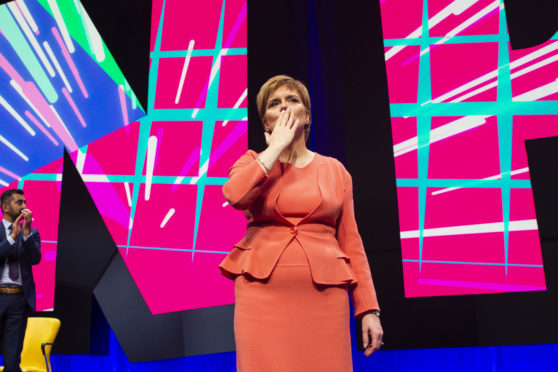Nicola Sturgeon didn’t need a warm-up act before her big speech yesterday afternoon.
The troops in Glasgow’s SECC had been gearing up since Saturday and were ready to hang on to their leader’s every word.
The problem was, the one word they wanted to hear most of all was one she has been trying to keep quiet recently: independence.
From the beginning of the conference on Sunday, party activists whooped at every mention of independence.
They had hyped themselves up the day before, in Edinburgh on Saturday, when around 20,000 of them (or 100,000 if you believe their own estimates) marched through the capital in the latest rally for separation.
Even with the legitimate EU vote that took place in 2016, some people are finding it hard to accept the result.
One of those is Ian Blackford, the SNP’s leader in the Commons, who has finally persuaded Sturgeon to back a second ballot on Europe, something she had been unwilling to support.
Conceding that referendums on Europe were not binding, but ones securing Scottish independence would be, must have been a tricky conundrum for the First Minister. But she has found a tortuous way around this hypothetical (for now) dilemma, explaining that there had been no detail in the Brexit campaign, so the electorate didn’t know what they were voting for.
In 2014, on the other hand, the SNP’s White Paper was “a detailed proposition, setting out the implications, setting out in advance some of the compromises that would be required – currency union, for example, continued regulatory harmony”.
Really? She must have been talking about a different referendum to the one the rest of us experienced in 2014, when confusion over an independent Scotland’s currency, not to mention made up figures about oil funds, persuaded the majority to vote No by a clear margin.
That majority has not changed its mind in the four years since, despite claims to the contrary by many nationalists.
A weekend poll for the Sunday Times showed that even with a no-deal Brexit, only 48% would opt for independence.
Another poll, conducted by Survation and commissioned by the SNP, found that an independence referendum tomorrow would result in 46% voting yes and 54% no.
This would change to 50 for yes and 50 for no if the UK leaves Europe as planned, and 52% backing yes and 48% no in a no-deal exit.
This is the best Brexit bounce the SNP can produce and it is not enough to risk staging, and most likely losing, a second independence vote.
In early September 2014, a YouGov poll put support for independence at 51 per cent and look what happened a couple of weeks later.
The reality is that despite the SNP being the party of government all these years in Scotland, and despite the unpopular (north of the border) EU vote, people’s stance on the United Kingdom has remained pretty stable.
Sturgeon knows this, which is why her independence rhetoric has focused on some point in the future rather than on a definite date in the present.


